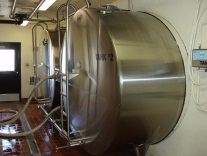NAHMS 311 Dairy 2014 Bulk Tank Milk and Filter Collection Record
National Animal Health Monitoring System; Dairy 2014 Study
NAHMS-311
Dairy 2014 Study
OMB: 0579-0205
![]()


Animal and Plant Health
Inspection Service
Veterinary Services
Dairy 2014
Bulk Tank Milk and Filter

National Animal Health Monitoring System
2150 Centre Ave, Bldg B
Fort Collins, CO 80526
Form Approved
OMB Number 0579-0205
Approval expires: XX/XXXX
Collection Record
State FIPS: |
Operation #: |
Collector: |
Date: |
Kit Number: |
Last known bulk tank somatic cell count |
___________(in thousand) |
||
Temperature of milk at time of collection |
__________degrees F |
Sample represents what percent of lactating cows in the herd? |
___________ percent |
Type of Milk Storage |
1 Tank 2 Silo |
Number of cows represented in the bulk tank |
|
Amount of time to collect and prepare samples |
__________ minutes (do not include travel time) |
||
Do NOT Freeze Samples
Call the operation to determine the best time of day to visit when the bulk tank will have milk from as close as possible to 100% of the lactating cows. If less than 75% of the lactating cows are represented in the tank at the time of the visit, do not sample.
The in-line filter(s) are also collected, but you may not be able to obtain those during your visit. The producer may be willing to collect filter samples. If so, ask the producer to place the in-line filter(s) in a clean plastic bag and refrigerate them for you. Ask the producer to collect enough filters to represent at least one milking cycle for the entire herd.
Farm personnel may wish to obtain the milk samples for you which is acceptable if done aseptically. It is also permissible for the milk truck operator to collect the needed samples.



NAHMS-311
JAN 2014
According to the Paperwork Reduction Act of 1995, no persons are required to respond to a collection of information unless it displays a valid OMB control number. The valid OMB control number for this information collection is 0579-0205. The time required to complete this information collection is estimated to average .15 hours per response, including the time to review instructions, search existing data resources, gather the data needed, and complete and review the information collected.
Confirm the Fed Ex Airbill matches the laboratory on the sample label.
Make sure the kit number printed on the labels match kit number on this form.
No paperwork is sent with the samples to the labs. Assure labels and paperwork are correct as it is the only way to connect data to sample results.
Review the collection instructions on back
General Precautions
Efforts should be made to reduce any contamination during the sampling process by conscientious hand washing and use of aseptic sampling technique.
Hand Washing
Prior to any sampling, hands should be washed with soap and water and dried with single use towels.
Wash hands any time they become contaminated during sampling.
Sampling Procedure for Tanks with Manhole Lids
1. Turn on agitator for a minimum of 5 minutes if the tank is less than 1500gal (5700L) capacity or for 10 minutes if tank is greater than 1500gal capacity. If agitator is running at the time of arrival, continue to agitate for times listed above.
2. Record the temperature of milk (if available) on the front of this form.
3. Turn agitator switch back to its original position.
4. Open manhole lid as little as necessary during sampling.
5. Open the pipette bag and remove one sampling pipette. Close bag immediately.
6. Attach the 60 ml syringe to end of the collection pipette and hold onto the pipette as you lower it into the tank. Collect 50ml of milk from the tank.
7. Remove the pipette, making sure to keep it from becoming contaminated and put the milk directly from the syringe into the sample container. Do not fill the sample container over the milk tank.
8. Close tank lid and hose or wipe any spilled milk off the tank.
9. Ask the producer for a milk filter to be included with the milk samples. Place in the gallon sized ziplock bag.
10. Write the State FIPS, Operation Number, and collection date on label and place on the milk vial and ziplock bag with filters. Seal the milk vials and filters in a separate ziplock bag to contain leakage during shipment, and place in shipping box with ice packs. Keep samples cool and ship within 24 hours.
A submission form is not sent to the laboratory, so it is important that the samples contain State FIPS, Operation number, kit number, and collection date.
Tank Filter
You may not be able to obtain a filter at the time of collection. So call the dairy the day before the visit to determine the best time of day to collect the milk samples and ask that when a milk tank filter is pulled out that it be refrigerated in a clean plastic bag.
| File Type | application/vnd.openxmlformats-officedocument.wordprocessingml.document |
| File Title | Perpiparturient Cow Clinical Evaluation Record |
| Author | APHIS:USDA |
| File Modified | 0000-00-00 |
| File Created | 2021-01-29 |
© 2025 OMB.report | Privacy Policy